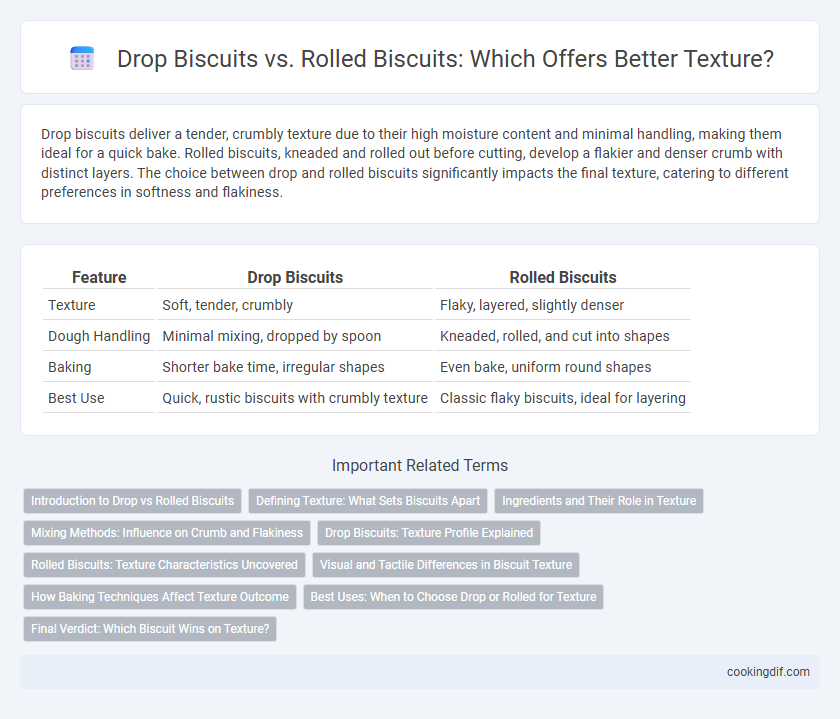Drop biscuits deliver a tender, crumbly texture due to their high moisture content and minimal handling, making them ideal for a quick bake. Rolled biscuits, kneaded and rolled out before cutting, develop a flakier and denser crumb with distinct layers. The choice between drop and rolled biscuits significantly impacts the final texture, catering to different preferences in softness and flakiness.
Table of Comparison
| Feature | Drop Biscuits | Rolled Biscuits |
|---|---|---|
| Texture | Soft, tender, crumbly | Flaky, layered, slightly denser |
| Dough Handling | Minimal mixing, dropped by spoon | Kneaded, rolled, and cut into shapes |
| Baking | Shorter bake time, irregular shapes | Even bake, uniform round shapes |
| Best Use | Quick, rustic biscuits with crumbly texture | Classic flaky biscuits, ideal for layering |
Introduction to Drop vs Rolled Biscuits
Drop biscuits have a softer, crumbly texture due to their wetter dough and no kneading, while rolled biscuits feature a flakier, layered crumb because of the folding and rolling process. Drop biscuits rely on a high moisture content and minimal handling to maintain tenderness, whereas rolled biscuits benefit from the incorporation of cold butter and repeated folding to develop distinct layers. Texture differences arise primarily from how the dough is prepared and shaped before baking.
Defining Texture: What Sets Biscuits Apart
Drop biscuits offer a tender, cakey texture due to higher moisture content and minimal handling, creating a soft crumb that almost melts in the mouth. Rolled biscuits result in a flakier, layered texture because the dough is rolled and folded, developing gluten strands that provide structure and a slightly denser bite. The key difference in texture arises from the preparation method, with drop biscuits being more delicate and rolled biscuits delivering a satisfying, flaky crispness.
Ingredients and Their Role in Texture
Drop biscuits, made with higher fat content and minimal mixing, yield a tender, crumbly texture due to fat coating the flour proteins, inhibiting gluten development. Rolled biscuits, kneaded and rolled before cutting, develop more gluten, creating a flakier, layered texture enhanced by cold butter pieces that steam during baking. The proportion of leavening agents like baking powder also influences the rise and softness in both types, with drop biscuits often requiring slightly more for their denser batter.
Mixing Methods: Influence on Crumb and Flakiness
Drop biscuits feature a wetter dough mixed minimally to maintain a tender crumb with a moist, cakey texture, while rolled biscuits require gentle folding and rolling to create distinct layers that enhance flakiness. The mixing method for drop biscuits emphasizes quick incorporation to avoid gluten overdevelopment, resulting in a softer, more crumbly bite. In contrast, rolled biscuits depend on lamination techniques during mixing and shaping to trap air and form a flaky, layered structure.
Drop Biscuits: Texture Profile Explained
Drop biscuits feature a tender, crumbly texture due to their higher moisture content and minimal handling, resulting in a softer bite compared to rolled biscuits. Rolled biscuits, by contrast, develop a flaky, layered texture through repeated folding and rolling, creating distinct layers and a denser crumb. Drop biscuits are ideal for a moist, cake-like consistency, making them perfect for quick preparation and serving with gravies or soups.
Rolled Biscuits: Texture Characteristics Uncovered
Rolled biscuits are characterized by their flaky texture, achieved through folding and rolling the dough to create multiple layers of fat and dough. This technique produces a light, tender crumb with distinct layers that separate easily when baked. Unlike drop biscuits, which have a denser and more rustic texture, rolled biscuits offer a delicate, buttery flakiness prized in Southern baking traditions.
Visual and Tactile Differences in Biscuit Texture
Drop biscuits exhibit a rough, craggy surface with an irregular shape, offering a dense yet tender crumb that feels moist and slightly crumbly to the touch. Rolled biscuits display a smooth, even surface with distinct, layered edges resulting from the folding and rolling process, producing a flaky texture that is light and airy when broken apart. Visually, drop biscuits appear more rustic and uneven, while rolled biscuits have a uniform, polished look that corresponds to their delicate, flaky interior.
How Baking Techniques Affect Texture Outcome
Drop biscuits create a tender, crumbly texture due to their higher moisture content and minimal handling, which prevents gluten development. Rolled biscuits, on the other hand, have a flakier, layered structure achieved by rolling and folding the dough, encouraging gluten formation for a chewier bite. Baking temperature and time also play crucial roles, with higher heat producing a crisp exterior while preserving the soft interior in both biscuit types.
Best Uses: When to Choose Drop or Rolled for Texture
Drop biscuits, made by spooning loose dough onto a baking sheet, offer a tender, crumbly texture ideal for casual meals and rustic presentations. Rolled biscuits, rolled and cut from stiffer dough, produce a flaky, layered texture perfect for dishes requiring a more structured and traditional biscuit form. Choose drop biscuits for moist, easy-to-make sides, while rolled biscuits excel when crisp edges and defined layers are desired.
Final Verdict: Which Biscuit Wins on Texture?
Drop biscuits offer a moist, tender crumb with a slightly uneven, rustic texture due to their higher moisture content and minimal handling, making them perfect for a soft bite. Rolled biscuits provide a flaky, layered texture achieved through careful folding and rolling, creating distinct, airy layers that deliver a satisfying crunch. The final verdict favors rolled biscuits for those seeking a flaky, layered texture, while drop biscuits delight with their tender, buttery softness.
Drop biscuits vs rolled biscuits for texture Infographic

 cookingdif.com
cookingdif.com